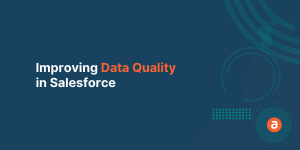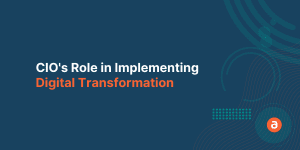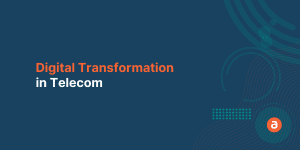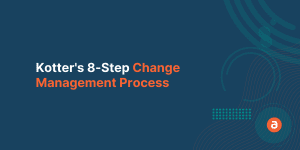E-Learning and modern learning management systems are vital parts of most companies’ employee onboarding and training process. As the COVID-19 pandemic continues to expand the use of work-from-home arrangements and all-remote teams, LMS training programs’ popularity will likely increase.
In this guide, we’ll examine how to utilize your LMS with a Digital Adoption Platform to deliver the best digital training experience for your employees and boost Digital Adoption across your organization.
Pros and Cons of Using an LMS
Learning management systems can be great tools in helping you onboard employees in a more efficient and engaging manner.

However, like everything, there are pros and cons to using LMS’s. You need to utilize best practices to be as efficient as possible. Otherwise, you’ll waste time with e-learning because your employees won’t get anything out of it.
So let’s go through some of the pros and cons of using an LMS.
What Are The Pros Of Using An LMS?
When appropriately used, LMS’s can significantly boost your employees’ productivity and morale.
- Tracking Employee Compliance – During the onboarding process, an LMS can help track your employees’ compliance. The LMS will keep track of all of their training and produce the records. This way, you can see where everyone is with their training and how they’re doing.
- Employees Can Complete Training At Their Convenience – Before utilizing digital tools, the training process could be arduous and stall productivity. You’d have to get all of the new hires in a room and have one of the staff members teach them the course. With online training, employees can complete the training when it’s convenient. They can still work and train this way, and productivity doesn’t have to come to a halt.
- Updated Training Programs – With an LMS, you can update the training as needed. Without an LMS, the same training program would be presented for an extended period of time. Not updating training materials leads to less employee engagement and knowledge retention. With an LMS, as soon as a new training program is available, they can put it on the system right away. Now training can be taken as soon as the new course is available. The information never becomes outdated.

What Are The Cons Of Using An LMS?
There can also be many cons to using an LMS is it isn’t utilized correctly. It can also be a gigantic waste of time if employees aren’t getting the information they need. So let’s go through some of the cons of using LMS’s
- Costly licensing, setup, and maintenance – For some companies, this might not be an issue. For others, creating a compelling business case to justify the cost of an LMS is difficult. If you used an open-source LMS, the system won’t be free, and you’ll need to pay for staff to maintain the system.
- Creating LMS courses is time-consuming – Your LMS is only as good as the content you publish. Creating and maintaining a robust training library requires you to invest significant resources into course authoring.
- Getting Employees To Use It Can Be Difficult – Many training courses offered on different LMS’s aren’t mandatory. This can be difficult for employee engagement. If you want all your employees to take additional classes, you’ll have to make them compulsory. Let everyone know about every update and course, to make sure that employees are using the system.
Make sure when you’re using LMS’s that you’re getting your employees engaged and providing great information. If you don’t take all of the necessary precautions, you can be wasting money and time.

Common Challenges of Using an LMS for Training and Onboarding
In the end, the pros outweigh the cons of using an LMS. However, there are quite a few problems that can arise if the process isn’t set-up properly.
So let’s go through some of the issues you might face when working with different LMS’s.

a. Using Too Many Administrators
This is a common problem that often confuses many employees. Some learning management systems let you add as many administrators as you’d like. But just because you can do that doesn’t mean that you should.
Administrators are in charge of adding new content, deleting, and making any necessary adjustments. If you have too many, then it’s harder to figure out who’s uploading what and deleting different content. This can cause confusion, and questions amongst your staff.
Keep the number of administrators reasonably low if you want to avoid any issues. That way, everyone is on the same page.
b. Not Making The Content Engaging
You need to properly understand the work style that best suits your employees when implementing a learning management system. Make the content more engaging for your employees. Add videos or slides that are helpful and engaging.
Without properly utilizing these steps, you could just be wasting time. By adding content that is irrelevant or not engaging, you can lose out on the whole point of an LMS in the first place. So make sure the content is exciting and easy to access.
c. Not Using The Right LMS
Switching LMS’s is not hard. A lot of employers believe that when they’ve used the same LMS for an extended period that they need to stick with it. Or that it would just be too time-consuming to change everything over. But it isn’t true.
There are many different LMS’s out there. Some of the older ones get outdated, and when this happens switching over to another LMS could be the best option for your company.
It’s easy to do, and in the long, it might save you a lot of trouble. So don’t get stuck using a system that isn’t yielding the results that you’d like.
d. Not Utilizing Content That You Already Have
This is a big one. Many companies believe that once you start using different LMS’s that everything needs to be done from scratch. Then they become a little skeptical because they think it’s going to be time-consuming to create loads of new content.
But the thing is, is that you likely already have loads of content. You’ve probably done a lot of training before using an LMS. So take some of that content. Videos, PDF’s and use it on the LMS that you’re working with.
This can save you a lot of time and stop you from creating content that you already have.
Make sure that you’re using these systems to your advantage to get the most out of them. Your employees need to be engaged, and the content needs to be fresh and easy to digest.
How to Utilize a Digital Adoption Platform with Your LMS
One of the most common questions we get at Apty is why a company should use both a digital adoption platform and a learning management system?
Both systems can be used for employee training and onboarding, but they go about it differently. A digital adoption platform helps employees learn while they work. A DAP includes on-screen guidance that walks employees through completing a process step-by-step inside your critical business applications.
An LMS is more similar to traditional training, just in a digital format. Employees can take an LMS course at their own pace, but it will still require them to be away from their work. An LMS doesn’t allow people to train while they work.
So what are the benefits of using both an LMS and a DAP?
i. Supplement on-screen guidance with LMS content
On-screen guidance is excellent for quickly onboarding employees and walking them through a process, but often can’t provide in-depth information about the process.
Consider using on-screen guidance from a DAP to walk users through a new process and then link to an LMS module where they can learn more.
For example, let’s say you need to update a process to comply with new regulations. You could deploy a guided walkthrough from your DAP to walk people through the process and require them to complete an LMS module and test to ensure they understand the new requirements.
ii. Make your LMS easier to use
If your LMS is challenging to use and learn, people won’t use it no matter how good the content is. Digital adoption platforms work with any web-based application, including your LMS. Some companies use DAPs to onboard users to their learning management system.
A DAP with cross-application linking features, like Apty, would allow you to create a seamless experience between your LMS training content and the real-world application in your enterprise software.
For example, you could create a workflow that guided uses by completing an LMS course and then directly into the application to complete a process for the first time.
iii. Reduce content authoring times with COPE
Creating content for training and onboarding is complicated and time-consuming. Apty makes it easy by enabling you to use the COPE method (Create once. Publish everyone).
COPE is based on a workflow used by media and marketing companies. For example, a newspaper might need an article for the next print issue, their website’s homepage, and in an email. Using COPE, editors could upload the article once.
The content management system would pull the headlines and photos to use for each medium instead of an editor having to enter the copy and graphics for each channel manually.
Apty makes the same thing possible for your training and LMS content.
It starts with creating a guided workflow in our code-free editor. You go through the process in your business software and tell Apty where to add on-screen guidance and what step to take next. Once you’re done, you publish the workflow.
Publishing makes the on-screen guidance available for employees to use inside your application. After creating and publishing your workflow, you’re now ready to create your documentation and LMS content.
From inside the Apty Admin portal, you’ll find your workflow, and you can export it in any format you need:
- Word Document
- PowerPoint
- Video
- Webpage
- Or a SCORM-compliant object you can import into your LMS.
You can create and publish documentation and add it to your LMS with a couple of clicks. Apty even does the hard work of taking all the screenshots.
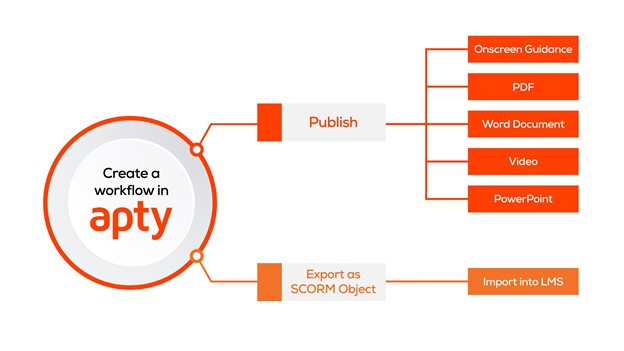
LMS and Apty: A Great Match
An LMS is a vital tool for your employee training program. A digital adoption platform like Apty can make it even more impactful. Apty solves some of the common problems of using an LMS by making the LMS easier for employees to use while also reducing the time and resources needed to create training content.
Digital training and employee development initiatives need the right tools. Make your programs a success by combining the power of an LMS with a leading digital adoption platform.


